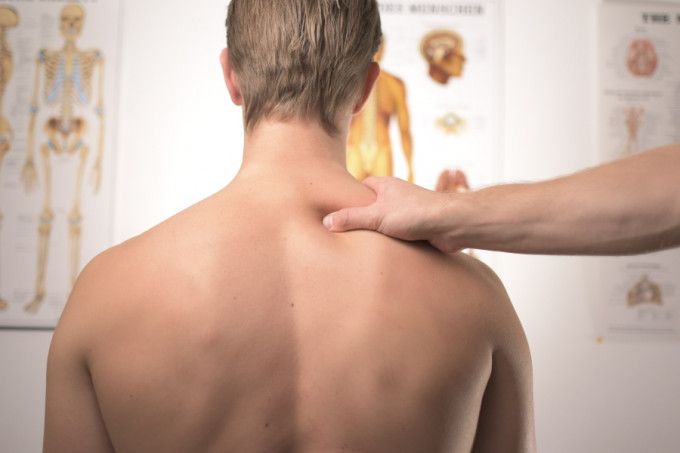
Guide To Neck, Shoulder & Back Supports
By Neesha Desai, Pharmacist
You can use supports to help your body deal with chronic pain, enable better posture and prevent and cope with injuries. Neck, shoulder and back supports come in many forms, including binders, braces, belts and other comfortable but strong detachable pieces of equipment.
Each support has a specific function and use and it is important to be clear on not only how to wear the support but how it should be used to support your body. This guide has been created with that in mind, taking a look at each of the supports for your neck, back and shoulder areas, what the supports are used for and how long you can/should wear them for. We also offer recommendations for each type of support.
Back Supports
Back supports are a great orthopaedic tool for dealing with back related pain and issues, from the minor and temporary to the prolonged and intense. How effective they are will adepend on the issue at hand. They can be used to aid recovery or as part of treatment but won't necessarily be the complete solution.
Back supports are typically abdominal wraps with straps and binding of various sizes and attachment styles to suit their intended way of supporting your back. There are also some back supports that wrap around the ribs and lower chest, though the most common are for lumbar (lower back) support. Pain anywhere in the back, only with strain and spasms, which can be the result of a number of conditions and situations, can be helped by back supports.
Arthritis
Thoracic Degenerative Joint Disease, also known as Osteoarthritis, is a degenerative condition which affects the middle of the back – under the rib cage on the spine. Symptoms of this kind of arthritis can range from swelling and redness, to back pain, to pain that radiates around the rib cage and muscle spasms.
To support the spine and control unwanted flexes which can lead to pain and strain, an upper back brace can be worn. This compression of the spine, with a comfortable fit, aims to enable relief from the discomfort caused by osteoarthritis.
Similarly, those suffering with lumbar arthritis symptoms in their lower back may find relief with back supports, particularly with waist belts.
It is important to note that, as with all arthritic conditions, you should consult with your GP about a treatment plan, which will typically include medication. Your GP will be able to tell you how a back support may help you and will advise how long and how often you can wear the back support to avoid issues as a result of your condition.
Muscle Spasms
Muscle spasms are involuntary contractions caused by your body trying to prevent movement, in an attempt to avoid overextension. Back muscle spasms are most common after bending, twisting or lifting heavy objects. You may be more prone to back muscle spasms because of a pre-existing back condition. The resulting stiffness and cramps can prevent you from going about your daily life, which is why you might seek out a back support.
Back supports, like braces and belts, can allow for a reduction in muscle tension, reducing spinal pressure and therefore reducing discomfort from back muscle spasms. The same back supports that work for arthritis in the back can be used to deal with muscle spasms in the same area.
While back supports can be used to deal with muscle spasms in the back, they aren't the only solution and are not necessarily a long-term one. If you are dealing with frequent or prolonged muscle spasms, you should speak to your GP or seek out a physiotherapist to see what they recommend.
Slipped/Trapped Discs
The discs being referred to are the soft cushions of tissue between the bones in your spine. When one moves out of alignment, it causes pain, which can lead to a sprain or strain – discomfort and pain that is coupled with swelling, spasms, cramping and/or inability to put weight on the area.
Slipped discs can occur due to inactivity, awkward bending or even a sneeze. You may also be more prone to them due to a back, bone or muscle condition. For the most part, slipped discs are uncomfortable or painful, but can be treated with rest or painkillers. However, if these are not possible or enough, a back support can offer relief from the discomfort.
Back Injuries
The impact of lower back injuries on your ability to move and use your back will depend on severity. As mentioned above, minor aches and pains can result from doing a simple task like lifting a heavy item, while more serious injuries can be sustained due to disorders or accidents. Each situation will be unique and depend on your own ability to rest and recover, but as part of the healing process you may find that back supports, such as lumbar back supports, are a valuable way of alleviating pain.
In particular, you might be recommended the use of a support for back injuries which have resulted in a fracture, or post surgery. A medical professional will make it clear if and when certain back supports can be used. They will also be able to suggest how long you can wear them to help you get about, while allowing enough time for your back to recover without it.
Regular Heavy Lifting
If you carry out heavy lifting as part of your job, such as if you are in construction or building maintenance, you may be more prone to the kinds of pains and strains that impact your back. Protecting your back is important if you want to avoid long-term pain or more serious issues, such as muscle and bone damage. Industrial back supports can help.
Back supports can help to strengthen your back area and ensure that you don't easily overextend your body while carrying out your job. Back supports, whether a whole back support or lower back belt, can also be used if you previously had an injury in your back or are recovering from a muscle spasm. Industrial back supports provide compression, strong support and are comfortable.
Shoulder Supports
Shoulder supports can be incredibly valuable when looking to gain relief from strain and pain in your shoulder area, across arm joints, collar bones and the shoulder itself. You'll most commonly find shoulder supports used in the recovery of injuries to avoid further damage to the area. They can also be used in the management of chronic conditions in the shoulder area.
There is really only one main shape to shoulder supports, though the amount of support they offer can vary. For example, they can be simple compression garments to help with shoulder discomfort or a more robust shoulder support that aids the management of injury recovery and chronic pain. They also come single or double sided so you can support a specific shoulder, or both. Which type you choose will depend on the reason for needing the support and the condition.
Rotator Cuff Injury
The rotator cuff is found around the shoulder joint and allows for a smooth movement; working in combination with the bones and muscles in the shoulder and arm. Although a single injury can cause issues in this area, rotator cuff injuries are more commonly the result of multiple small tears that become inflamed over time.
The causes range from overstraining to impingement – rubbing due to instability in part of the rotator cuff. Aging will play a part in how susceptible you are to these injuries, but so will your own genetics as some people are born with gaps that cause issues. Similarly, jobs where overextension is common, such as carpentry or professional tennis, increase the likelihood of injuries in the rotator cuff.
Treatment for rotator cuff injury will depend on the severity of the issues. At times this can mean surgery. For more minor injuries, shoulder supports can help aid recovery and reduce pain since they contain heat and encourage healthy blood flow through the shoulder. If surgery is required then shoulder supports can be used to assist with recovery from surgery and then to prevent further injuries by being worn during shoulder straining activities, such as sports and manual labour.
If you have been injured and are recovering, you should speak to your doctor about how shoulder supports may help with your recovery and pain management.
Sports Injuries
Muscle pain and spasms in the shoulder area caused by sports can be alleviated with shoulder supports. Rotator cuff injuries are very common in certain sports, particularly overarm sports like tennis and squash. But shoulder injuries can be incurred in all kinds of sports, from football to rugby and gymnastics.
A highly common, shoulder-related sports injury is the clavicle fracture. The clavicle is the strut between shoulder blades and your breastbone (sternum). Injuries to this area are often caused by falls on outstretched arms, common in sports. In fact, sports are a factor in almost half of all clavicle fractures. For these kinds of injuries, a clavicle brace can be used to stabilise the area and minimise additional damage.
For professional sports people, medical professionals should be consulted before using any supports, to ensure that they are being used correctly, such as during practices or at certain stages of the recovery process.
Stroke Recovery
The medical term for a stroke is cerebrovascular accident (CVA). 16% to 72% of patients who have a cerebrovascular accident experience shoulder pain, making it a significant additional consequence of a stroke. There are different types of stroke and depending on intensity they can lead to long-term problems, ranging from further strokes to mental health issues like depression and anxiety, alongside pain and having to re-learn skills such as speech and movement.
Shoulder supports are one way of assisting stroke patients who are recovering and experiencing pain by providing the right support to this part of their body. Your GP will be able to advise if and when a shoulder support can be used, and it may be that a sling is more appropriate than a full shoulder support in some cases.
Neck Supports
The neck is a very flexible part of the body, able to rotate in many directions. Because we use our necks all the time – in smaller ways than we might be conscious of – the cervical vertebrae, the bones that make up the neck, can easily be injured. A neck support may be required to restrict movement and support healthy recovery.
Neck supports, sometimes also known as cervical neck collars, are like other supports in that they are available in different formats to suit the seriousness of your injury or neck pain. Simple cervical collars made of dense foam wrapped in cotton can be used to alleviate neck pain from sore muscles or strains – these are more durable and supportive than the neck pillows you might wear on planes or when travelling.
More controlled neck supports include vinyl in their structure and are softened with foam for comfort when wearing, making them more suitable for conditions that require more neck control during recovery.
Whiplash
Whiplash is a neck injury caused by sudden head movement, most commonly associated with vehicle crashes, falls, or sports accidents. Symptoms vary in intensity from stiffness and slight pain, to losing range of motion, dizziness and headaches.
Pain from continuing to move your neck after whiplash might lead to wanting a way to restrict movement when up and about, such as by lying down as this will have a steadying effect on the neck and thus reduces pain.
You do not need to use a neck support to treat whiplash, in fact the NHS recommends not using one so you can encourage healing in your neck. You should see your GP if you have experienced whiplash or a scenario which could cause whiplash, so that they can check for broken bones and other injuries beyond whiplash.
Cervical Spondylosis
This medical name is given to the very common age-related wearing of the discs in your neck. The majority of over 60s experience cervical spondylosis, though many won't feel more than some soreness in their neck – along with other aging aches and pains. In some, the condition can worsen and the neck discs can herniate, pressing into the spine or nerves. Similarly, bone spurs can develop as extra bone grows to compensate for the deteriorated discs, which can also press in uncomfortable ways.
Those who have previously had a neck injury are more likely to develop cervical spondylosis and the related symptoms. A doctor will be able to prescribe medication to help treat this condition, providing pain relief and help with inflammation or muscle tension in the neck. Neck supports may make some patients feel more comfortable temporarily by reducing the strain on the neck, but it will be down to the individual's preference and comfort.
Disclaimer
The products offered are not intended to diagnose, treat, cure, or prevent any illness or disease, or to replace the advice of a medical professional. Results are not guaranteed and may vary from individual to individual.




